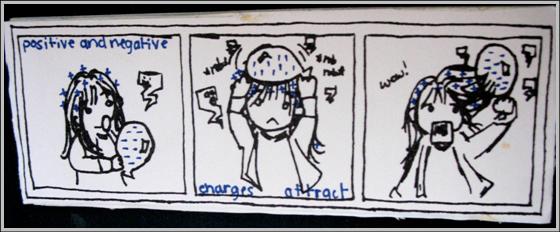Static Electricity
Paul Dufour and Gabriela Cervantes
All physical objects are made up of atoms. Inside these atoms are the subatomic particles: protons, electrons, and neutrons. Protons are positively charged, electrons are negatively charged, and neutrons are neutral.
Most of the time the positive and negative charges are balanced in the object, making it neutral. When an object loses electrons, it causes the object to have a positive charge. The object that picked up more electrons will have a negative charge. This is static electricity, the imbalance of positive and negative charges. (http://www.sciencemadesimple.com/static.html)
The charge of an object is measurable just like pounds or grams. The unit used to measure charge is Coulombs.
An object that has static electricity charges on its surface generates an electrical force field. The force field will strongly attract objects with opposite charges. It will mildly attract an object with neutral or no charges.
Rubbing the comb on the materials generates static electricity and results in the comb having a negative charge. This is caused by the comb and the material touching. Since the comb has a negative charge, it can pick up the pieces of paper and aluminum which do not have an excess of either charge.
The results will not all be the same. All the materials are made up of a different number of protons, neutrons, and electrons. The comb will pick up a different amount of paper versus aluminum.
Most of the time the positive and negative charges are balanced in the object, making it neutral. When an object loses electrons, it causes the object to have a positive charge. The object that picked up more electrons will have a negative charge. This is static electricity, the imbalance of positive and negative charges. (http://www.sciencemadesimple.com/static.html)
The charge of an object is measurable just like pounds or grams. The unit used to measure charge is Coulombs.
An object that has static electricity charges on its surface generates an electrical force field. The force field will strongly attract objects with opposite charges. It will mildly attract an object with neutral or no charges.
Rubbing the comb on the materials generates static electricity and results in the comb having a negative charge. This is caused by the comb and the material touching. Since the comb has a negative charge, it can pick up the pieces of paper and aluminum which do not have an excess of either charge.
The results will not all be the same. All the materials are made up of a different number of protons, neutrons, and electrons. The comb will pick up a different amount of paper versus aluminum.

